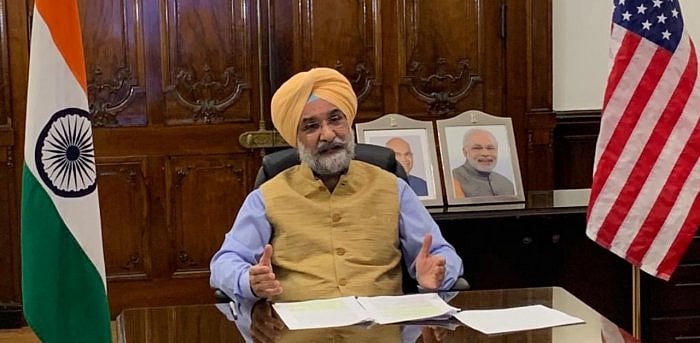
After declining to echo President Donald Trump’s administration in directly criticizing China for the Covid-19 pandemic and growing aggression in Indo-Pacific, India has now asked the United States to “look far, look ahead”, instead of being “agitated by short-term losses” in bilateral relations.
“While short-term gains might provide happiness and relief, we cannot afford to overlook where we want to be in the long run,” New Delhi’s envoy to Washington D.C., Taranjit Singh Sandhu, said while speaking on India-US relations.
“This also means that we cannot be complacent about short-term gains, nor can we be too agitated about short term losses. Look far, look ahead,” he said, addressing the Heritage Foundation, a think-tank in Washington D.C.
Sandhu emphasized on long-term goals of strategic partnership between New Delhi and Washington D.C., even as the Trump Administration prodded India to take a more hawkish stand on China, particularly in view of the communist country’s recent military moves to occupy vast swathes of its land in eastern Ladakh.
Mike Pompeo, the US Secretary of State, said that China had deployed 60000 soldiers of its People’s Liberation Army (PLA) along its disputed boundary with India.
He also said that India “absolutely” needed the US as its “ally and partner” in “this fight” against China.
Pompeo, who recently returned to Washington D.C. after a visit to Tokyo, gave interviews to American TV channels and slammed China for its hostility against India and Australia as well as for its aggressive moves in the Indo-Pacific region.
He had a meeting with his counterparts from other members of the ‘Quad’ in Tokyo – External Affairs Minister S Jaishankar of India, Foreign Ministers Maris Payne of Australia and Foreign Minister Toshimitsu Motegi of Japan.
Though the US Secretary of State minced no word to blame China for the Covid-19 pandemic as well as for its belligerence, none of his counterparts named or directly criticized the communist country. New Delhi apparently decided to tread cautiously as it was keen to dispel the perception that the five-month-long military stand-off along its disputed boundary with China was making it give up its strategic autonomy and pushing it closer to the US.
Pompeo was keen to use the meeting in Tokyo on October 6 to institutionalize the ‘Quad’, which was re-launched in November 2017 as a coalition of four democracies to counter-hegemonic aspirations of China in the Indo-Pacific region.
But his move to turn the four-nation coalition into a NATO-like bloc for Indo-Pacific did not succeed as not only India, but Australia and Japan too were not yet ready to go the whole hog and overtly gang up with the US against China.
New Delhi of late also avoided joining the US and 38 other nations at the United Nations in criticizing China for violation of human rights in Xinjiang, Hong Kong and Tibet.
With the diplomats and military commanders of the two sides still holding talks, India has not yet given up hope for resolving the stand-off with China in eastern Ladakh through dialogue. That was why it declined to join the US in Tokyo in turning the Quad into a block, which would appear to be overtly adversarial to China.
The US National Security Advisor, Robert O’Brien, however, said that the time had come for the international community to accept that dialogue would not bring about any change in the behaviour of China. He also particularly referred to India-China military stand-off along the Line of Actual Control (LAC) – the de facto boundary between the two nations.
The comments by Pompeo and O’Brien apparently reflected the Trump Administration’s unease over India’s reluctance to join the US in launching a tirade against China.
Sandhu, however, sought to underline the long-term vision of India-US relations. “Look broad, look deep. Both our countries need to look at the big picture. We cannot afford to see things in silos however hard the temptation may be,” said India’s ambassador to the US. He said that the strength of the partnership would come from strengthening each other. “India’s growth is not in its interest alone. A secure and prosperous India is in the interest of the region, and the world at large.”
His comment came even as the two sides started preparations for the India-US 2+2 dialogue, scheduled to take place in New Delhi on October 26 and 27. Jaishankar and Defence Minister Rajnath Singh would host their counterparts, Pompeo and Mark T Esper, for the dialogue, which would be the last high-level bilateral engagement before the US presidential elections on November 3. The US Deputy Secretary of State, Stephen Biegun, will visit New Delhi early next week to prepare for the talks. He will hold meetings with Foreign Secretary Harsh Shringla and other senior officials of India.

